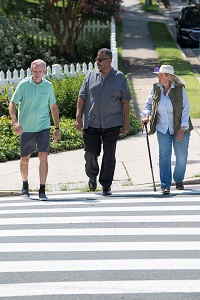
What is a pedestrian?
A pedestrian is anyone on foot and any person with disabilities traveling in a wheelchair or a mobility device to help an individual overcome a disability. See Wis. Stats. 340.01(43) for the legal definition of a pedestrian.
Everyone is a pedestrian at some point, whether commuting to the bus stop, entering or exiting a building, or just out for a walk.
Pedestrians are in a world dominated by motorists, however, and collisions with motor vehicles do occur. An average of 53 pedestrians are killed and about 1,300 are hurt in crashes every year in Wisconsin.
Preventing crashes for vulnerable pedestrians
Injury prevention and travel safety begins with a mutual respect between both motorists and pedestrians.
Street or road crossings are the most common locations of pedestrian crashes. Any street crossing can put a pedestrian in the path of a motor vehicle whose driver may not be paying attention or may not have the time to avoid a pedestrian who suddenly steps into their path.
Children and pedestrians with limited mobility are at a greater risk than others on the roads. Children have a limited understanding of traffic laws and little sense of danger. They tend to be impulsive and don’t take the time to stop and think about safety, and children may also have a difficult time judging the speed of approaching cars. Their smaller stature makes them harder for motorists to see. Adults need to take special care to teach children how to behave safely when around vehicle traffic.
Older pedestrians are more at risk because they do not have the same ability to recover from injuries as younger pedestrians, and many may take longer to cross the street or have difficulty seeing or hearing traffic clearly.
These challenges call attention to the need for all travelers to focus on pedestrian safety rules that are designed to reduce needless crashes and prevent injuries and deaths.